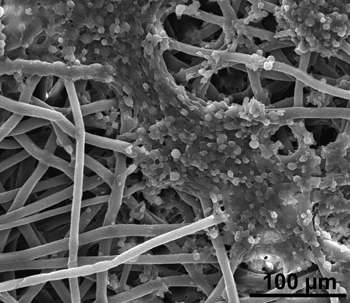Researchers see more realistic tumor growth and response to anti-cancer drugs using polymer scaffolds

(Medical Xpress)—Porous polymer scaffolds fabricated to support the growth of biological tissue for implantation may hold the potential to greatly accelerate the development of cancer therapeutics.
Researchers at Rice University and the University of Texas MD Anderson Cancer Center in Houston and Mount Sinai Medical Center in New York reported this week that three-dimensional scaffolds used to culture Ewing's sarcoma cells were effective at mimicking the environment in which such tumors develop.
Their research appears online this week in the Proceedings of the National Academy of Sciences.
"The scaffolds better recapitulate the microenvironment in which tumors grow, as compared with two-dimensional plastic surfaces typically used in cancer research to test anti-cancer drugs," said Rice bioengineer Antonios Mikos, who led the research team with Joseph Ludwig, an assistant professor and sarcoma medical oncologist at MD Anderson.
"We've been working to investigate how we can leverage our expertise in engineering normal tissues to cancerous tissues, which can potentially serve as a better predictor of anti-cancer drug response than standard drug-testing platforms," Mikos said.
By growing cancer cells within a three-dimensional scaffold rather than on flat surfaces, the team of researchers found that the cells bore closer morphological and biochemical resemblance to tumors in the body. Additionally, engineering tumors that mimic those in vivo offers opportunities to more accurately evaluate such strategies as chemotherapy or radiation therapies, he said.
The project "provides a path forward to better evaluate promising biologically targeted therapies in the preclinical setting," Ludwig said.
Scaffolds fabricated in the Mikos' lab facilitate the development and growth of new tissue outside the body for subsequent implantation to replace defective tissues.
The team found 3-D scaffolds to be a suitable environment for growing Ewing's sarcoma, the second most-common pediatric bone malignancy. The tumor growth profile and protein expression characteristics were "remarkably unlike" those in 2-D, Mikos said.
These differences led them to hypothesize that 2-D cultures may mask the mechanisms by which tumors develop resistance to anti-cancer therapeutics, and "may lead to erroneous scientific conclusions that complicate our understanding of cancer biology," they wrote.
The next challenge is to customize scaffolds to more accurately match the actual conditions in which these tumors are found. "Tumors in vivo exist within a complex microenvironment consisting of several other cell types and extracellular matrix components," Mikos said. "By taking the bottom-up approach and incorporating more components to this current model, we can add layers of complexities to make it increasingly reliable.
"But we believe what we currently have is very promising," he said. "If we can build upon these results, we can potentially develop an excellent predictor of drug efficacy in patients."
More information: www.pnas.org/cgi/doi/10.1073/pnas.1221403110
















